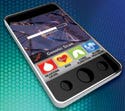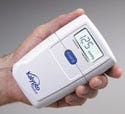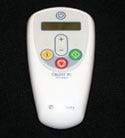Developing Medical Devices in a Consumer-Driven Market
As consumers seek more control over their healthcare, manufacturers must design safe and effective devices that look and feel like everyday electronic products.
February 1, 2009
COVER STORY: DESIGN
|
Medical care in the United States is becoming increasingly consumer-driven, and medical devices are proliferating among the general population. This trend places new pressures on device designers and manufacturers. Consumers are more involved in healthcare purchasing decisions than ever before, and many medical products that were once designed for and marketed to medical professionals are being targeted directly at patients.
The average consumer is inundated with more than $6 billion worth of pharmaceutical ads annually, according to TNS Media Intelligence. The company also estimates that the rapidly rising marketing of medical devices to the public reached $193 million in 2007. This level of advertising points to the direct influence consumers are expected to have on device purchasing decisions, and with that influence comes changing expectations for product performance. The following headlines and popular medical blogs reflects this growing trend:
“An Open Letter to Steve Jobs,” Diabetes Mine.1 Blog discusses the need for devices such as insulin pumps to look more like iPods.
“Wireless Health Monitoring Comes to Life,” medGadget.2
“Medtronic Automates Pain Relief with Palm PDA,” Business Week.3
“Borrowing from Apple Playbook, Medical Device Makers Focus on Design, Consumer Appeal,” TheDeal.com.4
Consumer wants and needs are dictating that personal medical devices look and feel like everyday electronics. For years, device developers have offered insulin pumps that look like pagers, monitoring devices that feel like personal digital assistants, and medical electronics on wearable platforms, but consumers are asking for more. Patients want to minimize the stigma of their reliance on medical technology, and they want their medical devices to have the same kind of design appeal as iPods. This push for convergence of the medical and consumer market spaces brings a complex set of challenges to device designers. These challenges include widely divergent product life cycles, varying scenarios of use, and safety and efficacy concerns.
Convergence Challenges
|
Kalypto Medical's NPD 1000 negative-pressure wound therapy system is a portable, low-power, and battery-operated suction pump. It uses negative pressure, or a vacuum, to remove a small amount of fluid from the wound bed, including exudate and infectious material, to help wounds heal. (Photo courtesy of KALYPTO MEDICAL) |
Consumer electronics product life cycles are typically measured in quarters if not months. This is in stark contrast to medical devices that can take a long time to get
the necessary regulatory approvals, and then have even longer adoption and use periods. Consumers have expectation, driven by their everyday electronics experiences, that state-of-the-art technology will be rapidly deployed in their world. Intense competition in the consumer markets has dramatically reduced the time it takes for concepts to move from labs to the marketplace. The modern electronic marvels that power personal electronics include microcomputer platforms, wireless communications, batteries, displays, and mass-storage devices. In addition, consumers are expecting these state-of-the-art technologies to appear in their medical devices as well.
For a number of reasons, however, this has generally been difficult to achieve. For one thing, regulatory approval cycles have not dramatically improved. According to FDA's Office of Device Evaluation, premarket approval (PMA) time saw a decrease from 438 days to 335 days between 2005 and 2006, although that was up from 229 days in 2003.5 The time for premarket notification 510(k) approval saw an increase from 87 days to 95 days over the same period. These durations do not reflect the submitter's preparation time to meet increasingly stringent regulatory requirements and guidelines. The average product development times for medical devices varied by FDA classification with the following distribution:6
Class I devices: 27 months.
Class II devices: 22.5 months.
Class III devices: 36 months.
In the time it can take a medical device to get from the drawing board to widespread adoption, the fundamental design components—processors, displays, mass-storage elements, batteries—may experience multiple generations of changes or outright retirement. For example, one company was recently involved in a major new product development program for a large device manufacturer. During the 28-month course of development, the entire user interface subsystem had to be redesigned because the display controller and associated memory became obsolete without warning. The more consumer-oriented a component is, the more likely it is to quickly evolve (or fall out of demand), and that evolution may ultimately be tied to rapid obsolescence.
|
Mobility and comfort are key factors in any consumer-oriented product. Belt-worn devices free patients from bulky console-based systems. (Photo courtesy of KALYPTO MEDICAL) |
To meet this challenge, designers and system architects need to bring to bear a greater depth and breadth of understanding. They need to recognize, manage, and possibly avoid—through experience and dialogue with vendors—state-of-the-art technologies that are intimately tied to consumer electronics, even though this may compromise the ability to meet patient expectations for usability, size, and other performance factors. Specifically, a knowledgeable designer will consider the following:
Avoid the use of components developed specifically for high-volume consumer applications. These include highly concentrated or integrated macrofunction integrated circuits such as display and disk controllers, network interfaces and controllers, nonstandard battery configurations, or display modules specifically designed for consumer products. By using more-fundamental and less-specialized building blocks and components that are well established in industrial applications, designers can minimize the risk of obsolescence.
Work closely with manufacturers and distributors to identify components suitable for long product life cycles and actively track obsolescence issues. Regular communication with component manufacturers, distributors, and printed circuit assembly partners can greatly aid in this regard. There are also a number of online subscription resources such as Promiere (www.promiere.com) that can provide early warning of obsolescence. The Center for Advanced Life Cycle Engineering at the University of Maryland (www.calce.umd.edu) also has a number of valuable life cycle management tools and guides.
Design for upgradability. By creating processor, display, and memory architectures (including software) that are flexible, designs can be quickly adapted to changing conditions. This often comes with a price in terms of size and cost, but may be well worth it over the life of a product.
Balance demand for consumer product look with product life cycle expectations for medical devices.
Usage Scenarios
A medical device's changing use scenario can further complicate the situation and introduces challenges not common to consumer devices. For instance, a monitor-programmer for an implantable device might be used in an operating room and to follow a patient to a step-down unit, to an outpatient care facility, and ultimately, home. The users of such a device might include a surgeon, a perfusionist, a nurse, a cardiologist, a technician, a caregiver, and a patient. The expectations are very different in each user environment, and they might appear to require three or four different products. The realities of development costs and time, however, may make that impractical. A successful device needs to be adaptable to a variety of settings and present itself appropriately while ensuring the safety of the patient.
Designing a product for a specific medical specialty is obviously quite different from designing one for the average consumer. Traditional targets for medical devices included physicians, nurses, technicians, and healthcare systems personnel. Diversity of users was a term that was used to describe the difference between a surgeon and a cardiologist. And for some medical specialists, speed of execution can trump ease of use, even if extensive training is required. This is rarely the case for products aimed at a broad consumer base. Today's markets for medical devices include the acutely and chronically ill, rehabilitation patients, the elderly, and technologically savvy teens.
One company recently worked with a client to introduce a chronic wound-healing system for ambulatory use. This product is worn by a wide range of patients with chronic wounds and takes the place of a large console unit that was operated by a trained caregiver. As a consequence, the design of the device needed to be robust, inconspicuous, wearable, extremely simple to operate, and accommodate users young and old with a variety of ailments. This was a clear departure from the predicate benchtop device that was targeted at a very specific professional operator.
|
The Urgent PC neuromodulation system, manufactured by Uroplasty Inc., is designed to be used in a physician's office for treating urinary urgency, urinary frequency, and urge incontinence. It provides percutaneous tibial nerve stimulation with a slim needle electrode that is inserted near the tibial nerve to carry electric impulses from a handheld stimulator to the sacral plexus. (Photo courtesy of MINNETRONIX) |
One way to meet such a challenge head-on is to employ a strong usability process that identifies use cases and users, and ensures that designs are safe and intuitive. To address this need, a company can develop a standard operating procedure for user-centered design that complies with ANSI/AAMI HE74:2001, IEC 62366 Ed. 1.0 2007-10, and FDA guidance on usability engineering. This process includes user research, conceptual and detailed design, user interface implementation, and extensive testing and verification to make certain that the end result is suitable for a product's intended use.
Although not every company has user-centered design expertise in-house, there are many capable firms that can provide this resource and can help create software that meets consumer expectations for intuitive and convenient use (much like an iPod). In other cases, the user-centered design process may identify the need to develop software that is both flexible and configurable. This is needed in order to create a single product that has multiple personalities targeted at specific user groups such as those described earlier in the heart monitor case. By recognizing these needs and creating dynamic platforms, a company can develop instruments and products for patient monitoring that are intuitive and useful for a broad spectrum of patients.
Safety and Efficacy
A final differentiating factor for medical devices relative to consumer products is clearly the higher bar that is set in terms of safety and efficacy. Lockups and reboots are not acceptable, and dropped communications or corrupted and unsecure data transfer can have serious implications. Medical devices are scrutinized by regulatory agencies to levels far beyond consumer products, adding significant requirements that affect both development efforts and product costs. Couple this with increasing healthcare pricing pressures, and meeting the demand for flashier, higher-tech medical devices becomes even more challenging.
Once again, engineering experience and judgment play key roles in determining feature and risk-reward trade-offs for medical devices. It can be difficult to anticipate exactly which state-of-the-art technology will provide true user value and product differentiation. Only by weighing the costs against the benefits of using a structured, quality function deployment-type process can one work through the alternatives. System architects should consider the following regarding risk-reward trade-offs:
Ensure that the core function of a medical device provides real outcome benefits.
Employ a trade-off matrix that weighs implementation time, production costs, safety impact, and user features.
Carefully review FDA guidance documents when making architecture and product design decisions. Applicable documents include FDA's guidance, Medical Device Use-Safety: Incorporating Human Factors Engineering into Risk Management. This guidance discusses how to deal with potential hazards, which can occur as a result of interactions between users and devices, in the development phase.
Apply a structured risk management methodology early in the process to identify key safety features that must be integrated with user preferences. Such features may include fault tolerance, redundant subsystems, user interface functions, and alert and alarm handling.
Employ state-of-the-art technology (wireless, virtual reality, and multifunctional touch screens) when contributing to the safety and efficacy of a device, including convenience, but not for the purpose of employing technology for technology's sake.
Conclusion
Ultimately, the responsibility of creating safe and reliable medical devices that appeal to consumers is that of product development and manufacturing teams. Judgment must be used in assessing technology, diligence practiced in evaluating customer wants and needs, and completeness achieved in the execution of designs and processes. Such balance will result in satisfied users of medical devices regardless of the audience.
Rich Nazarian is president and CEO of Minnetronix (St. Paul, MN). Contact him at Rich Nazarian is president and CEO of Minnetronix (St. Paul, MN). Contact him at [email protected].
References
1. Amy Tenderich, “An Open Letter to Steve Jobs,” Diabetes Mine; available from Internet: www.diabetesmine.com/2007/04/an_open_letter_.html.
2. “Wireless Health Monitoring Comes to Life,” medGadget, July 31, 2008; available from Internet: http://medgadget.com/archives/2008/07/wireless_health_monitoring_comes_to_life.html.
3. Reena Jana, “Medtronic Automates Pain Relief,” Business Week (2006); available from Internet: www.businessweek.com/innovate/content/jan2006/id20060112_923303.htm.
4. “Borrowing from Apple Playbook, Medical Device Makers Focus on Design, Consumer Appeal,” TheDeal.com, December 6, 2007; available from Internet: www.thedeal.com/techconfidential/vc-ratings/money-in/design-consumer-appeal-key-in.php.
5. Office of Device Evaluation Annual Report, Fiscal Year 2006 and Fiscal Year 2007, CDRH, FDA; available from Internet: www.fda.gov/cdrh/annual/fy2007/ode/report.pdf.
6. D Dixon et al., “Experiences of New Product Development in the Medical Device Industry,” Medical Device Technology 17, no. 3 (2006).
Copyright ©2009 Medical Device & Diagnostic Industry
About the Author(s)
You May Also Like







